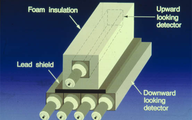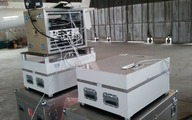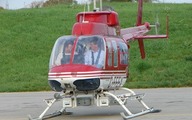
Radiometrics
Airborne Gammaray Spectrometry (AGRS) provides a direct measurement of the surface of the earth, with no significant depth of penetration. This at-surface characteristic allows us to reliably relate the measured radioelement contrasts to mapped bedrock and surficial geology, and alteration associated with mineral deposits. All rocks, and materials derived from them are radioactive, containing detectable amounts of a variety of radioactive elements. A gamma-ray spectrometer is designed to detect the gamma rays associated with these radioactive elements, and to accurately sort the detected gamma rays by their respective energies.
Calibration of Gammaray Spectrometers
The recorded counts of a gammaray spectrometer are subject to a certain amount of Compton scattering that results in extra counts being recorded in each of the 3 regions (peaks) of interest. The effects of this scattering can be removed if the spectrometer has been properly calibrated to determine a set of 6 constants called 'stripping ratios'.
The Gammaray Spectrometer
The AGRS is a self-stabilizing spectrometer, and tracks and corrects for the spectral drift by following a spectral peak, typically thorium. The standard regions of interest (listed below) are recorded and processed as a standard. The 1024-channels digital data is also recorded and provided to the Client.
FEATURES & BENEFITS:
- Energy detection range 20 KeV to 3 MeV
- 256 / 512 / 1024 channels
- Output is fully linearized and the Poisson Distribution is not affected
- Individual detector processing
- Real-time stabilization on natural radioactive elements
- Extremely wide dynamic range: up to 250,000 cps per detector
- Insignificant Dead Time
- Individual detector Acquisition and Live time is provided
- Stabilization time of less than 40 seconds on the ground
- All data acquisition is accomplished via Ethernet, which eliminates bandwidth problems and permits remote monitoring and trouble shooting
- Selectable sampling rates from 10 Hz to 0.1 Hz
- High level of self-diagnostics
- Automatic HV calibration and linearization based on natural radioactive elements (radioactive sources are NOT required). This permits field replacement of NaI(TI) detectors and/or photomultiplier tubes
- Solid-state hard disk drive for logging gammaray data
- GPS connectivity & synchronization
The Gammaray Sensors
The sensors used with McPHAR's AGRS advanced multi-channel gamma-ray spectrometers are typically the AGRS-1024 and AGRS-1024/256 models. These sensors each contain a “downward-looking” array of 16.8 litres of NaI(TI) detector. The AGRS-1024/256 also has an “upward-looking” detector comprised of 4.2 litres of NaI(TI) detector.
Fixed-wing Platform
The typical configuration of sensors for a fixed-wing platform is one AGRS- 1024/256 and one AGRS-1024, providing a total sensor volume of 33.6 litres “downward-looking” and 8.4 litres “upward-looking”. The thermally isolated sensors are usually installed in the cabin of the aircraft.
Helicopter-borne Platform
A typical helicopter-borne system is usually comprised of either one AGRS- 1024/256 or one AGRS-1024, providing a total sensor volume of 16.8 litres “downward-looking", and in the first instance also with 4.2 litres “upward- looking”.
The thermally isolated sensor is usually installed in the cabin of the helicopter, but in some instances, when a small helicopter is being used, the sensor may be installed outside the helicopter under the fuselage, or in some cases, a specially designed set of sensor housings (see figure below) may be used.
 |
 |
 |
| The detector configuration in the AGRS-1024/256 sensor. Note that lead shield is not required, as the downward looking array partially shields the single upward detector from terrestrial radiation - the Up/Down counts relationship is determined. | AGRS Advanced Airborne Gammaray Spectrometer system with 33.6 litres of detector "downward-looking" and 8.4 litres "upward-looking" before installation in aircraft. | An AGRS gammaray spectrometer system for helicopter installation, featuring an AGRS-1024/256 sensor with an instrument rack sitting on-top of the sensor containing the IMPAC data acquisition console and other ancillary devices. |
 |
||
| AGRS sensors housed in specially designed and certified containers mounted on the skids of a Bell 206L Long Ranger helicopter. |